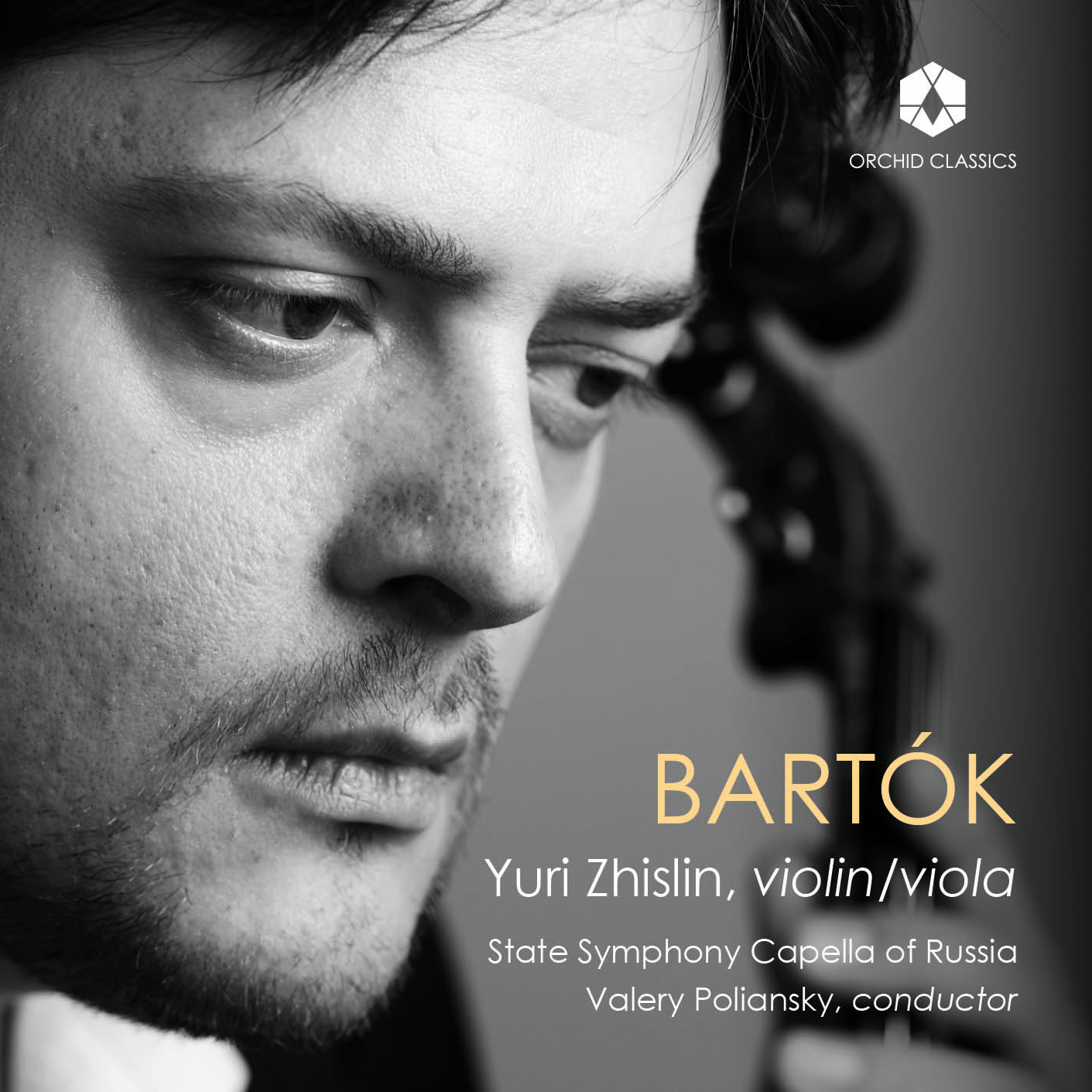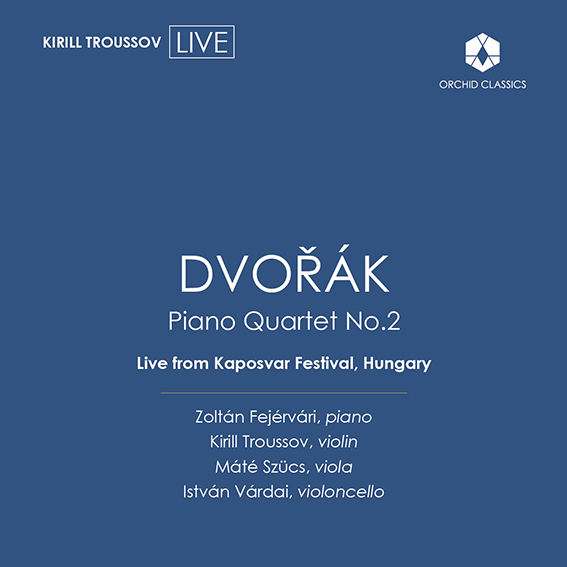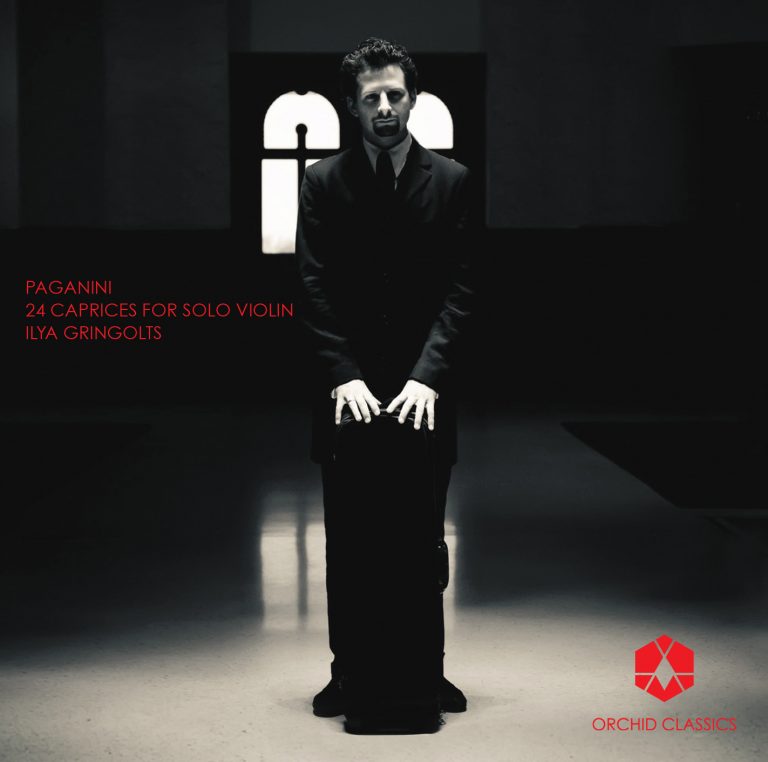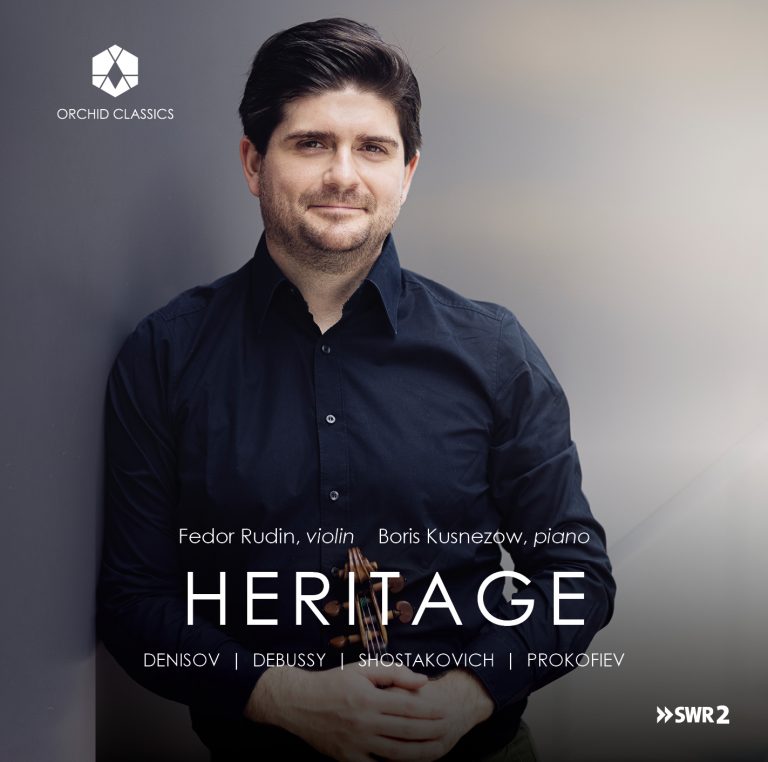Artist Led, Creatively Driven

BARTÓK
Yuri Zhislin, violin/viola
State Symphony Capella of Russia
Valery Poliansky, conductor
Release Date: May 24th
ORC100304 - Bartók
Béla Bartók (1881-1945)
Concerto for viola and orchestra (Op.post.)
1. I Moderato
2. II Adagio religioso
3. III Allegro vivace
Prepared for publication from the original manuscript by Tibor Serly
Concerto for violin and orchestra, No.1 (Op.post.)
4. I Andante sostenuto
5. II Allegro giocoso
Romanian Folk Dances, Sz.56, BB 68
6. Jocul cu bata (Stick Dance)
7. Braul (Sash Dance)
8. Pe Loc (In One Spot)
9. Buciumeana (Dance from Bucsum)
10. Poarga Romaneasca (Roman Polka) and Maruntel (Fast)
Arranged for violin and string orchestra by Yuri Zhislin
Yuri Zhislin, violin/viola
State Symphony Capella of Russia
Valery Poliansky, conductor
In 1940, Belá Bartók and his wife Ditta left Hungary for the last time and travelled to the USA. Although initially optimistic about the professional opportunities in their new home, Bartók soon discovered that almost the only work he was urged to accept was the one kind of work in which he had no interest: teaching composition at music colleges and universities, which he felt would imperil his own creative powers. He did undertake some concert tours and ethnomusicological research but felt increasingly depressed by the global situation and found it hard even to compose. By the spring of 1942, he was also clearly unwell, and suffered periods of ill-health over the next few years which eventually culminated in the leukaemia that would eventually kill him.
Nevertheless, new projects did eventually begin to appear: the Concerto for Orchestra was commissioned in 1943, and the violinists Tossy Spivakovsky and Yehudi Menuhin began to perform his pieces in high-profile concerts. Among several new commissions, he received a request from the Scottish-born violist William Primrose for a viola concerto. Primrose recalled that Bartók was initially ‘quite reluctant, because he felt he didn’t know enough about the possibilities of the viola as a solo instrument. I admired his integrity because at that time he sorely needed the money’. He encouraged Bartók to listen to an upcoming performance of the Walton Viola Concerto; and the composer also sought out the score of Berlioz’s Harold en Italie for study. This preparation clearly set his mind at rest, and he accepted Primrose’s commission, working on it during the summer of. He wrote to Primrose in early September to announce that the work was ready in draft, but warning that ‘it is conceived in a rather virtuoso style. Most probably some of the passages will prove to be uncomfortable or unplayable. These we will discuss later, according to your observations.’
Bartók was not overstating the case when he branded the Concerto highly virtuosic. The first movement is broadly lyrical in character, which often disguises the viola’s deft leaps and twirls as the music unfolds, the orchestra taking a backseat and presenting themes only after they have been introduced by the soloist. The second and third movements are considerably more compact: a sweetly consolatory ‘Adagio religioso’, followed by a cheerfully showy moto perpetuo folk-style finale.
And yet the piece as we hear it here is not entirely by Bartók. By late September 1945 the composer was very ill, working from his bed. When he died on 26 September, the Concerto was still in its unorchestrated draft, and was later completed by Bartók’s friend Tibor Serly. Serly freely admitted that this was a challenging task: the piece was written on unnumbered scraps of paper, with corrections written over earlier versions in a way that took considerable work to decipher. ‘What for Bartók would have been a matter of working out the details and scoring involved for another person a lengthy task that required infinite patience and painstaking labour,’ he recalled. It was finally premiered in 1949, with Primrose as the soloist, in Minneapolis.
Whilst the Viola Concerto belongs to the end of Bartók’s career, the First Violin Concerto is the work of a man in his mid-twenties – who was also hopelessly in love. The object of his affection was the virtuoso violinist Stefi Geyer, seven years his junior, with whom he became smitten in 1907. That summer, Bartók began writing a Concerto for her (although his surviving correspondence with Geyer suggests that although the discussed a wide variety of topics, she was not altogether taken with his views of the world and the romance was almost certainly doomed from the beginning). The piece makes extensive use of a four-note figure which Bartók described to Geyer as ‘your Leitmotiv’, and which begins the Concerto, the solo violin entering alone. It’s a dreamy first movement, the leitmotiv saturating the orchestral texture around the almost ever-present soloist: indeed, by the climax we are hearing Geyer’s motto in both its original and mirror forms, stacked through the ensemble. Bartók marks an ‘attacca’ into the following Allegro giocoso – a virtuoso tour de force that draws together ferocious solo passagework, the unmistakeable influences of Richard Strauss and Richard Wagner, early hints of Bartók’s mature folk-derived textures and rhythms, and passing memories of the mellifluous first movement.
Bartók completed his Concerto in early 1908, and his relationship with Geyer came to an end very soon afterwards. He presented her with a manuscript copy of his piece, inscribed ‘My Confession: For Stefi, from times still happy. Although it was only half happiness.’ Their brief relationship also inspired a clutch of chamber and piano works, including Bartók’s First String Quartet. The Concerto did not receive its premiere until 1958, years after Bartók’s death, though he incorporated much of the first movement into the first of his Two Portraits for violin and orchestra, which is entitled ‘One Ideal’.
Our programme is completed by one of Bartók’s best-loved works: his Six Romanian Folk Dances. These were completed in 1915 following an extensive song-collecting trip to Bihar County in Romania, and initially rendered as a simple piano transcription ‘as if for use in schools’. He subsequently provided a version for small orchestra in 1918, and the work has appeared in numerous other arrangements since.
The Romanian Dances are vivid miniatures; we are led through a succession of finely-characterised pieces – and the succession, and connection between each item is as significant and carefully-planned as the individual movements themselves. We are led from the proud formality of the opening dance to the scurrying Brâul; from here to the swaying quasi-Oriental melody of Pe loc, with its accompaniment of bare fifths; and via the impassioned, almost Romantic outpouring of Buciumeana to the two energetic dances with which the set concludes. The pieces were dedicated to Professor János Buşiţia, a teacher and polymath and a close friend of the composer, whom he accompanied on several major song-collecting tours.
© Katy Hamilton
Yuri Zhislin
Violin/Viola
Russian born violinist and violist Yuri Zhislin has been described by The Strad as “a musician with lyrical talent and truly romantic temperament”. He studied at the Royal College of Music, obtaining his ARCM Diploma with Honours. A winner of the BBC Radio Two Young Musician of the Year 1993, Zhislin has appeared as a soloist with orchestras worldwide, including the BBC Concert Orchestra, the London Mozart Players, the Oxford Philharmonic, the Belgrade Philharmonic, the Armenian Symphony orchestra, the Queensland Symphony, the Lublin Philharmonic and the Santiago de Chile Symphony among others. Yuri has worked with conductors including Fabio Mastrangelo, Olari Elts, Alex Walker, Maciej Tworek and Maximiano Valdes.
His performances have taken him to nearly 50 countries around the world. In 2014, Zhislin made his debut at the legendary Carnegie Weill Hall in New York. Yuri has directed many string ensembles including the Camerata Nordica, the Armenian Chamber orchestra, the Baltic Neopolis Strings, the Podlaska Philharmonic Strings and the Oxford Philharmonic Strings in a number of projects. Yuri’s chamber music and recording partners have included Maxim Vengerov, Natalie Klein, Maria Joao-Pires, Sergei Nakariakov and his wife Natalia Lomeiko. He has made a number of recordings for SIMM, Naxos, Attoll, Lynn and Nimbus Alliance record labels, and has an ongoing recording collaboration with Orchid Classics, both as a soloist, chamber musician and an Artistic Director of the Camerata Tchaikovsky string orchestra.
Camerata Tchaikovsky, founded by Zhislin in 2004, has completed a series of tours across Europe and South America since 2008. In April 2016, a debut CD under their former name, the Russian Virtuosi of Europe, was chosen “BBC Music Magazine CD of the month” and in December 2021, their Christmas Without Words EP reached No.12 on the US Classical Billboard Chart.
Yuri has made several arrangements for various formations. The recording of the Glazunov’s Saxophone Concerto arranged for viola and strings by Zhislin is available on the Camerata Tchaikovsky Russian Colours album, (described by The Strad as a “revelatory arrangement”). He also arranged a few of the Christmas favourites for the Camerata Tchaikovsky Christmas EP album. An active jazz enthusiast, Zhislin regularly takes part in jazz events, and incorporates jazz elements into his arrangements.
As a conductor, Yuri has worked with orchestras in Russia, Spain and the UK. His recent appearances as a Guest conductor included a concert with the Bristol Ensemble at St George’s Bristol (described as “a concert wonderfully held together by Yuri Zhislin”) and conducting the up-and-coming Hastings Philharmonic orchestra in a concert at the White Rock Theatre in Hastings.
Zhislin is a professor of violin, viola and chamber music at the Royal College of Music and gives masterclasses across Europe. Among his former students are members and Principals of leading European orchestras, including the Royal Opera House, the London Philharmonic and the Royal Philharmonic orchestras, as well as members of established chamber ensembles. Yuri actively collaborates with his former and present students in various chamber music projects.
Zhislin is regularly invited as a Jury member to International Violin Competitions. In 2024, he will head an international Jury at the Kreutzer Violin Competition in Belgium.
The recent highlights include directing Camerata Tchaikovsky in the Jazzical Christmas Extravaganza concert at the iconic St John’s Smith Square in London, leading an electro-acoustic Quartet project in the Musikverein’s Metallener saal in Vienna, the release of his long-awaited Bartok album on Orchid Classics, touring Australia and New Zealand with Natalia Lomeiko and taking part in a recording for Sony Classical.
www.zhislin.com
Symphony Orchestra of the State Capella of Russia
Symphony Orchestra of the State Capella of Russia has had a rich history since 1957. During the USSR period the orchestra was led by Samuel Samosud, Yuri Aranovich, Maxim Shostakovich and Gennady Rozhdestvensky. Outstanding Russian conductors such as Yevgeny Svetlanov, Nathan Rachlin, Neeme Jarvi and Vladimir Fedoseyev performed with the orchestra throughout its career.
The orchestra has performed in the USA, Canada, Germany, Spain, Great Britain, Greece, Japan and Taiwan, appearing at concert venues such as Carnegie Hall and Lincoln Center in New York, Kennedy Center in Washington DC, Vienna’s Musikverein and Gewandhaus in Leipzig among many others. In 1991, the Symphony Orchestra has merged with the State Chamber Choir, and the following year Valery Polyansky became its Artistic director and Principal conductor. The orchestra’s vast repertoire covers works by the Russian and Western classics of the 18th and 20th centuries as well as contemporary music scores by A. Schnittke and S. Gubaidulina. Their large discography is available on the Melodyia, Сhandos records, Vista Vera and Japanese record labels.
Valery Polyansky
Conductor
Valery Polyansky was born in 1949 in Moscow and graduated from the College at the Moscow Conservatory. During his studies Polansky met Gennady Rozhdestvensky, who had a great influence on the young musician.
In 1971, he founded a Moscow Conservatoire Chamber Choir and became a conductor of the Moscow Operetta Theatre.
Polyansky has worked with leading orchestras worldwide, appearing as a Guest conductor in Iceland, Finland, Germany, Holland, the USA, as well as Taiwan and Turkey. He staged Tchaikovsky’s Eugene Onegin at the Gothenburg Music Theatre in Sweden and for several years was a Principal conductor of the Opera Nights festival in Gothenburg. Since 1992 Valery Polyansky has been the Artistic Director and chief conductor of the State Academic Symphony Capella of Russia.









